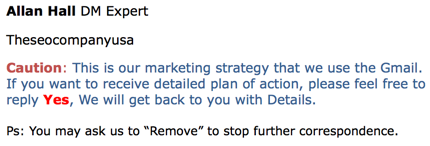Not a customer you want
Earlier this week one of my ESP clients contacted me. They have a new (potential?) customer dealing with some delivery challenges. Client was looking for advice on how to move the customer over and improve their delivery at the same time.
My advice was actually pretty simple: this isn’t a customer you want. Walk away.
I reached that conclusion about 10 seconds after I loaded the customer’s website. Because I know sometimes initial impressions are wrong, I did spend about 10 more minutes poking around. What I found did nothing to change my mind or convince me my initial impression was wrong. In fact, everything I found reinforced the belief that this was not a good customer for my client.
I sent my client an email explaining what I’d found and they agreed. Future deliverability problem averted!
Some of what I found inspired the conversations with spammers blog post from earlier this week. For instance, the website had two different signup forms, each pointing to a different ESP. Both links were dead.
Then I looked at the company’s whois record and found a bunch of cookie cutter websites, all with different domain names, all with the same broken subscription links.
I do this manually and I can’t fathom how you would automate this kind of checking. For me, it seems there absolutely needs to be a human in the loop. But I suspect that there are ways to automate these types of checks.
In any case, there’s a spammer looking for an email service provider. He’s having problems with IP reputation at his current ESP. He sends content and will even share with you the domain he’s using to collect email addresses. Pro tip: try and sign up for his mail before he signs your contract.

